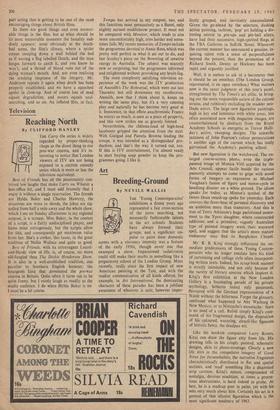Art
Breeding-Ground
By NEV1LE WALLIS
THE 'Young Contemporaries' exhibitions a dozen years ago represented a fair cross-section of the more searching, not necessarily fashionable talents in the art schools. Students have always formed their groups, and a significant im- pulse to paint dour domestic scenes with a visionary intensity was a feature of the early 1950s, though never one that swamped a show. Impassioned isolationists could still make their marks in something like a preparatory school of the London Group. More recently, really since the first impact of new American painting at the Tate, and with the readier communication of all kinds offered, for example, in Art International, the dominating character of these parades has been a jubilant awareness of whatever is astir, however imper-
fectly grasped, and inevitably unassimilated. Given, the go-ahead by the selectors, dashing action painting, tachism, 'pop' art holding a dis- torting mirror to ,pin-ups and pin-ball alleys, have had their successive, high-spirited flings at the FBA Galleries in Suffolk Street. Whenever the current manner has announced a genuine, in- quiring talent with a sense of purposefulness beyond the present, then the promotion of a Richard Smith, Denny or Hockney has been rapid and arguably justified.
Well, it is useless to ask of a barometer that it should be an omnibus. (The London Group, rejuvenated, is an open omnibus.) What matters now is the saner judgment of this year's panel, strengthened by The Times's art critic, in bring- ing out the more responsible nature of the current strains, and ruthlessly excluding the madder neo- Dada antics. The large new figurative paintings, high in key and luminous with white areas, less often associated now with magazine images, are counterbalanced by abstracts from the Royal Academy Schools as energetic as Trevor Halli- day's active, sweeping designs. The scientific jazziness of John Pearson's colour permutations is another sign of the current which has lately galvanised the Academy's painting school.
But new figuration is the watchword. The en- larged coarse-screen photo, even the triple- painted image of Monica Vitti acquired by the Arts Council, appear facile beside the various painterly attempts to come to grips with novel forms of imagery as expressive as Michael Vaughan's fusion of figure and motor-cycle in headlong disaster on a white ground. The idiom speaks for today, as Minton's symbol of the James Dean smash-up spoke for yesterday. Each conveys the fever-heat of personal discovery and an ambition more than transitory. And this is true of Terry Atkinson's huge partitioned monu- ment to the Ypres slaughter, where constructed additions and a primitive, vaguely Australian type of painted imagery work their wayward spell, and suggest that the artist's more mature endeavour may find its Burghclere Chapel.
Mr. R. B. Kitaj strongly influenced the im- mediate predecessors of these Young Contem- poraries who no longer emulate here his kind of cartooning and collage style often incorporat- ing written texts. Indeed, his scrap-book manner is strictly inimitable, and not only because of the variety of literary sources which inspires it. Kitaj's first exhibition at the New London Gallery is a fascinating parade of his private mythology, hitherto tasted only piecemeal, flavoured with the German expressionism of a Nolde without the bitterness. Forget the glossary, confound what happened to Aby Warburg in New Mexico, or to Nietzsche's moustache: there is no need of a cult. Relish simply Kitaj's com- mand of his fragmented design, the disposition of his coloured, wavering, stencil-like figments of historic fancy, the deadpan wit.
Like his bookish compatriot Larry Rivers, Kitaj can draw the figure ably from life. His drawing tells in his crisply painted, schematic designs, akin to photo-montage. Clearly a new life stirs in the compulsive imagery of Good News for Incunabulists, the narrative fragments characteristically distributed in flat and spatial sections, and 'read' something like a disjointed strip cartoon. Kitaj's nature, compounded of nostalgia, devious erudition, at times a preten- tious abstruseness, is hard indeed to probe. At best, he is a madcap poet in paint, yet with his wits very much about him. Certainly his art is a portent of that allusive figuration which is the most significant tendency of 1963.


































 Previous page
Previous page